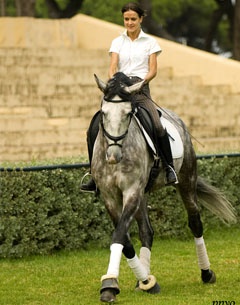
I love reading articles that say "and then we start the shoulder-in" as if that sums it up! Probably if you have trained numerous horses to Grand Prix level, the shoulder-in comes as naturally to you as the aid to go to canter. However, for most of us the shoulder-in is much more difficult to achieve
and even if we know how it should theoretically go, putting it into practice is far more difficult!
We have all read that around the age of 5 or 6, when a young horse has established rhythm and balance, we should begin to incorporate lateral exercises into our training. Executing these exercises on a young horse which has no idea what you are asking him to do is not as simple as pointing him in the right direction and giving an aid.
The first time I asked shoulder-in, I performed what I term "the screw myself up into a ball" routine and zig zagged my way pathetically up the long side, with Batialo wondering why I was collapsing above him.
Most commonly, when beginning the shoulder-in, riders tend to shift their weight onto their outside seatbone and slump over to create a highly ineffective slouch position towards the inside of the horse. This then forces us to draw our inside leg up, making the inside leg aid almost completely ineffective, and at the same time throwing us off balance and forcing the horse's energy to escape, normally through the outside shoulder.
Truth is getting a good shoulder-in is extremely difficult and it requires not only the technical knowledge, but a great deal of rider concentration and co-ordination to get it right! If your horse is falling in, losing the three tracks, not gaining enough angle, losing rhythm, not establishing the correct bend, falling through the outside shoulder, or wobbling hysterically in and out from the wall, it's because of you!
Firstly, the best way to begin shoulder-in, is out of the corner, and the rider should use the corner to their advantage, ensuring they get the balance, and the bend ready, to ease into the shoulder-in
"Shoulder-in is a passing of the corner which continues until the end of the long side of the arena." N.Oliveira (1998, 63).
Alternatively, the shoulder-in can be started out of a ten metre circle and Mariette Withages uses this is an effective way to set up the angle. Mariette instructed me to begin the small circle in the corner and as I reached the long side to continue on the circle one stride, until my horses shoulders came off the track, and then, use a long, relaxed touching inside leg to ask the horse to continue up the long side.
A rider's position in the shoulder-in is of course crucial, and many, myself included, have a tendency to curl up into a ball. The important thing to remember is to sit tall, open up your inside shoulder, put your weight down your inside leg, and allow the horse to move across with the use of an open and supple hip.
In the shoulder-in hold your body against your outside elbow. A good shoulder-in should enable the rider to give with the inside rein, and maintain the power through the use of inside leg into outside rein aids.
"Demanding the shoulder-in means controlling the outside rather than driving the inside." N.Oliveira (1998, 63).
The coming out of the shoulder-in is equally important and a good way to check the rider had maintained outside rein stability. In the beginning, go only half way down the arena, and then use the outside rein to ease the horse across the diagonal. This will set up an easy straighten after the shoulder-in, which is often overlooked by riders, the shoulder-in's completion.
Finally, the trot you have when you enter the shoulder-in is crucial! "If I have the horse well in front of both legs, and soft on the inside rein as I go into the shoulder-in, it usually falls into place by itself, so to speak," said dressage rider Kicki Linnell Fraser.
by Sarah Warne for Eurodressage
Related Link
Classical Training Articles by Sarah Warne